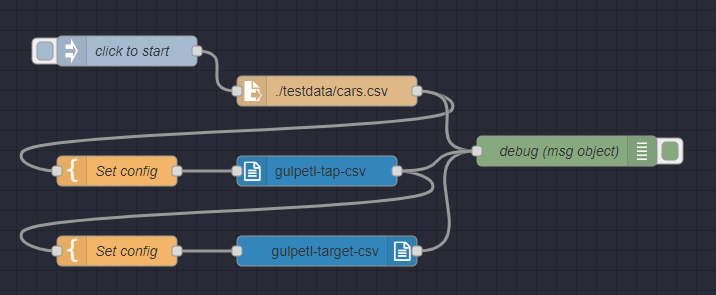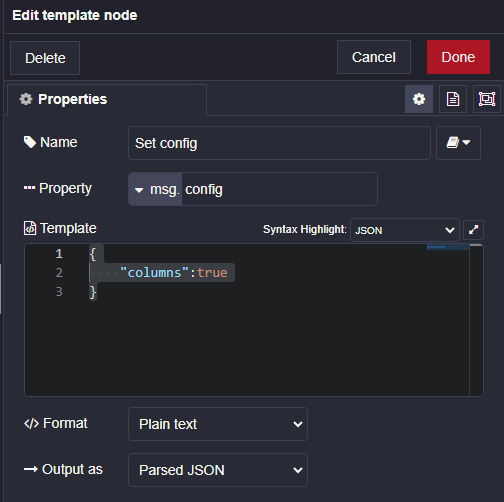gulp-etl-tap-csv v1.0.11
gulp-etl-tap-csv
This plugin converts CSV files to gulp-etl Message Stream files; originally adapted from the gulp-etl-handlelines model plugin. It is a gulp-etl wrapper for csv-parse.
This is a gulp-etl plugin, and as such it is a gulp plugin. gulp-etl plugins work with ndjson data streams/files which we call Message Streams and which are compliant with the Singer specification. In the gulp-etl ecosystem, taps tap into an outside format or system (in this case, a CSV file) and convert their contents/output to a Message Stream, and targets convert/output Message Streams to an outside format or system. In this way, these modules can be stacked to convert from one format or system to another, either directly or with tranformations or other parsing in between. Message Streams look like this:
{"type": "SCHEMA", "stream": "users", "key_properties": ["id"], "schema": {"required": ["id"], "type": "object", "properties": {"id": {"type": "integer"}}}}
{"type": "RECORD", "stream": "users", "record": {"id": 1, "name": "Chris"}}
{"type": "RECORD", "stream": "users", "record": {"id": 2, "name": "Mike"}}
{"type": "SCHEMA", "stream": "locations", "key_properties": ["id"], "schema": {"required": ["id"], "type": "object", "properties": {"id": {"type": "integer"}}}}
{"type": "RECORD", "stream": "locations", "record": {"id": 1, "name": "Philadelphia"}}
{"type": "STATE", "value": {"users": 2, "locations": 1}}Usage
gulp-etl plugins accept a configObj as the first parameter; the configObj
will contain any info the plugin needs. For this plugin the configObj is the "Options" object for csv-parse, described here; the only differences are around the columns option.
If its columns option is false csv-parse returns arrays for each row instead of objects, but the Singer spec specifies objects ("JSON maps") for the record property. So, we default to true (which tries to auto-discover column names from first line, and returns lines as objects), and if you set columns to false, the arrays returned will be converted to objects: e.g. ["valueA", "valueB"] becomes {"0":"valueA", "1":"valueB"}.
Sample gulpfile.js
/* parse all .CSV files in a folder into Message Stream files in a different folder */
let gulp = require('gulp')
var rename = require('gulp-rename')
var tapCsv = require('gulp-etl-tap-csv').tapCsv
exports.default = function() {
return gulp.src('data/*.csv')
.pipe(tapCsv({ columns:true }))
.pipe(gulp.dest('output/'));
}gulp-data
This plugin supports the use of the gulp-data api for passing in its configObj parameter. This allows data/options from the pipeline to be used to create options passed to this plugin when it runs.
See the demonstration in debug/gulpfile.ts for usage examples.
Node-RED
Node-RED is a low-code, visual programming environment for event-driven applications. Install this node under Manage Palette, look for gulp-etl-tap-csv
Demo flow

This demo builds upon the more basic demo flow for gulp-etl-target-csv; here we'll use this plugin to parse a CSV file into gulp-etl's Message Stream format, and then use gulp-etl-target-csv (npm) to convert it right back; a nice round trip. As you see, all of the nodes except gulp-etl-tap-csv and gulp-etl-target-csv are standard nodes that ship with Node-RED.
CSV data
For our demo, we'll save this CSV file to the testdata subfolder of our starting folder--which is where we ran node-red. Or we could just use a full path, which is actually recommended...
carModel,price,color
"Audi",10000,"blue"
"BMW",15000,"red"
"Mercedes",20000,"yellow"
"Porsche",30000,"green"Set config
The config is also set in a Template node. Identical to the configObj above, it is the "Options" object for csv-parse, described here, and you can set any of the properties described.

Results
When we run, we'll watch the Debug console; we can see the data parsed into as Message Stream. This intermediate format is used by all gulp-etl plugins/nodes, and allows for smooth interactions between them all.
{"type":"RECORD","stream":"cars","record":{"carModel":"Audi","price":"10000","color":"blue"}}
{"type":"RECORD","stream":"cars","record":{"carModel":"BMW","price":"15000","color":"red"}}
{"type":"RECORD","stream":"cars","record":{"carModel":"Mercedes","price":"20000","color":"yellow"}}
{"type":"RECORD","stream":"cars","record":{"carModel":"Porsche","price":"30000","color":"green"}}And when it finishes, the data should be back in CSV format again!
Flow code
Copy the demo flow for import in Node-RED under Import:
[{"id":"bd15ad43f5227ed0","type":"file in","z":"cd67672e19ab739a","name":"","filename":"./testdata/cars.csv","filenameType":"str","format":"utf8","chunk":false,"sendError":false,"encoding":"none","allProps":false,"x":330,"y"
:380,"wires":[["57240500756eadd1","bd4928a1fe33a509"]]},{"id":"5a22ef69893bbc79","type":"inject","z":"cd67672e19ab739a"
,"name":"click to start","props":[{"p":"payload"},{"p":"topic","vt":"str"}],"repeat":"","crontab":"","once":false
,"onceDelay":0.1,"topic":"","payload":"","payloadType":"date","x":130,"y":340,"wires":[["bd15ad43f5227ed0"]]},{"id"
:"7e1608b8b0ea106d","type":"gulpetl-target-csv","z":"cd67672e19ab739a","name":"","x":330,"y":540,"wires"
:[["bd4928a1fe33a509"]]},{"id":"16687292eb745dab","type":"template","z":"cd67672e19ab739a","name":"Set config","field"
:"config","fieldType":"msg","format":"json","syntax":"plain","template":"{\n \"quoted\":false,\n \"header\":true\n}",
"output":"json","x":120,"y":540,"wires":[["7e1608b8b0ea106d"]]},{"id":"5e5268849aacb118","type":"gulpetl-tap-csv","z"
:"cd67672e19ab739a","name":"","x":320,"y":460,"wires":[["16687292eb745dab","bd4928a1fe33a509"]]},{"id"
:"57240500756eadd1","type":"template","z":"cd67672e19ab739a","name":"Set config","field":"config","fieldType":"msg"
,"format":"json","syntax":"plain","template":"{\n \"columns\":true\n}","output":"json","x":120,"y":460,"wires"
:[["5e5268849aacb118"]]},{"id":"bd4928a1fe33a509","type":"debug","z":"cd67672e19ab739a","name":"debug (msg object)"
,"active":true,"tosidebar":true,"console":false,"tostatus":false,"complete":"true","targetType":"full","statusVal":""
,"statusType":"auto","x":570,"y":440,"wires":[]}]Quick Start for Coding on This Plugin
- Dependencies:
- git
- nodejs - At least v6.3 (6.9 for Windows) required for TypeScript debugging
- npm (installs with Node)
- typescript - installed as a development dependency
- Clone this repo and run
npm installto install npm packages - Debug: with VScode use
Open Folderto open the project folder, then hit F5 to debug. This runs without compiling to javascript using ts-node - Compile to javascript:
npm run build
Testing
We are using Jest for our testing. Each of our tests are in the test folder.
- Run
npm testto run the test suites --> Note: This document is written in Markdown. We like to use Typora and Markdown Preview Plus for our Markdown work..